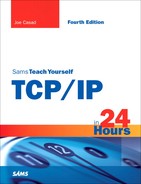Ethernet
Ethernet is undoubtedly the most popular LAN technology in use today. The ethernet architecture has become popular because of its modest price; ethernet cable is inexpensive and easily installed. Ethernet network adapters and ethernet hardware components are also relatively inexpensive. You are probably familiar with the appearance of a typical ethernet port and cable if you have ever looked at the back of a computer. The rise of wireless networking has not diminished the importance of ethernet. An important form of wireless LAN networking is sometimes called “wireless ethernet” because it incorporates many of the principles of the original ethernet specification.
On a classic ethernet network, all computers share a common transmission medium. Ethernet uses an access method called Carrier Sense Multiple Access with Collision Detect (CSMA/CD) for determining when a computer is free to transmit data on to the access medium. Using CSMA/CD, all computers monitor the transmission medium and wait until the line is available before transmitting. If two computers try to transmit at the same time, a collision occurs. The computers then stop, wait for a random time interval, and attempt to transmit again.
CSMA/CD can be compared to the protocol followed by a room full of polite people. Someone who wants to speak first listens to determine whether anybody else is currently speaking (this is the Carrier Sense). If two people start speaking at the same moment, both people will detect the problem, stop speaking, and wait before speaking again. (This is Collision Detect.)
Traditional ethernet works well under light-to-moderate use but suffers from high collision rates under heavy use. On modern ethernet networks, devices such as network switches manage the traffic to reduce the incidence of collisions, thereby allowing ethernet to operate more efficiently. You’ll learn more about hubs and switches in Hour 9, “Getting Connected.”
Ethernet is capable of using a variety of media. Conventional hub-based 10BASE-T ethernet was originally intended to operate at a baseband speed of 10 Mbps, however, 100 Mbps “fast ethernet” is now quite common. 1,000 Mbps (Gigabit) ethernet systems are also available. Early ethernet systems often used a continuous strand of coaxial cable as a transmission medium (Figure 3.4), but by far the most common scenario today is for the computers to attach to a single network device (Figure 3.5).
Figure 3.4. In an earlier form of ethernet, the computers were all attached to a single coaxial cable.

Figure 3.5. On modern ethernet networks, the computers are typically attached to a central network device such as a switch.

